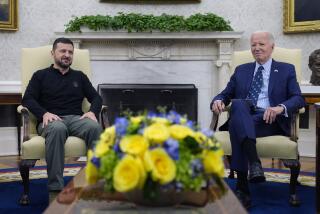U.S. Export-Import Bank Grants Preliminary OK to Russian Jet Project
The Export-Import Bank of the United States gave preliminary approval Tuesday to a controversial Russian aircraft project that would create jobs for a dozen U.S. aerospace contractors--but which Boeing and McDonnell Douglas argue would subsidize a foreign challenger to their dominance of the global aircraft market.
The details were finalized in meetings Tuesday in Washington between Vice President Al Gore and Russian Prime Minister Viktor Chernomyrdin.
The $1-billion loan guarantee, which still requires final bank approval, subsidizes the sale of Pratt & Whitney engines, Rockwell International avionics and other U.S. equipment that would be used in 20 Ilyushin IL-96M/Ts being built by Ilyushin Design Bureau for lease to Russia’s Aeroflot-Russian International Airlines. The Export-Import Bank said the Russian venture would provide work for as many as 340 companies in 30 states.
Pratt & Whitney spokesman Mark Sullivan said late Tuesday that the company was thrilled with the long-awaited decision, which smoothes the way for acquiring badly needed financing for the high-risk Russian venture.
Pratt has invested more than $100 million in Russia and is considering a joint-venture manufacturing facility with Perm Motors, a giant Russian firm. The first IL-96 production plane will be built in the spring, and Russian certification is expected later this year.
“This was a very critical step,” Sullivan said.
But Boeing and McDonnell Douglas, which campaigned against the deal in Washington and California, argued that the U.S. government would be helping to launch a Russian government-backed aircraft company that could become a major rival in world markets. They cited the challenge posed by Airbus Industrie, a European venture that is the world’s second-largest aerospace manufacturer and which U.S. companies have long complained is unfairly subsidized by European governments.
Boeing and McDonnell Douglas also fear the Russian loan would set a precedent for U.S. financing of other foreign aircraft, such as Airbus, which carry a high percentage of U.S. equipment. The Export-Import Bank does not provide financial support to Airbus.
Faced with strong resistance from Russia’s supporters within the Clinton administration, Boeing and McDonnell Douglas dropped their public opposition to the loan while the two governments negotiated a compromise.
An announcement is expected today on a separate agreement giving U.S. aerospace firms greater access to the Russian market, according to administration and industry sources. They indicated that the Russian government would agree to reduce its 30% tariffs on imported aircraft and parts.
Dick Dalton, a Boeing spokesman, said the company would not comment on the Export-Import Bank decision until all the details of the U.S.-Russian aerospace agreement are public.
“Until there is an official White House announcement, Boeing feels it is only appropriate to withhold comment,” he said.
The IL-96M/T is considered Russia’s best shot at the global market because it offers a solid aircraft frame equipped with U.S. technology for about one-third less than its nearest competitors--the Boeing 777 and 767, MD11 and the Airbus A330 or 340. The estimated price tag of the Russian jet is between $66 million and $75 million, compared with $100 million to $110 million for its Western competitors.
While many nations harbor ambitions to join the elite club of global jetliner manufacturers, Russia and China offer the most serious challenge because of their low-cost labor, stockpiles of key ingredients such as titanium and aluminum, and a huge domestic airplane market, according to industry experts.
Russia is particularly worrisome because, unlike China, it has a huge pool of aerospace talent remaining from the days when the Soviet Union directed much of its limited resources to its high-visibility military and space programs.
Wolfgang Demisch, managing director of New York-based B.T. Securities, said the U.S. aerospace firms have legitimate concerns about the long-term threat posed by the IL-96, particularly in India and China, where many Russian planes operate.
Over the years, the Export-Import Bank has quietly worked behind the scenes to help U.S. firms sell their products in places where the political and economic risks made it difficult to get private financing. In flush times, the U.S. government also used its financing programs to reward allies and prop up shaky governments in regions considered vulnerable to perceived threats such as communism.
But the end of the Cold War and the globalization of the U.S. economy has made it a lot tougher to determine just which corporate horses the U.S. government should place its bets on. This is particularly true in civilian aerospace, where U.S. firms have taken on a distinctly foreign flavor because of their expanding list of overseas partners, subcontractors and customers.
The U.S. firms involved in the IL-96M/T were reluctant to criticize Boeing--a leading customer and political heavyweight--too harshly. But they argued that it is hypocritical of the Seattle aerospace firm, itself a major beneficiary of Export-Import Bank programs, to oppose the bank’s support for an international aircraft project with such a high U.S. content.
More to Read
Inside the business of entertainment
The Wide Shot brings you news, analysis and insights on everything from streaming wars to production — and what it all means for the future.
You may occasionally receive promotional content from the Los Angeles Times.










